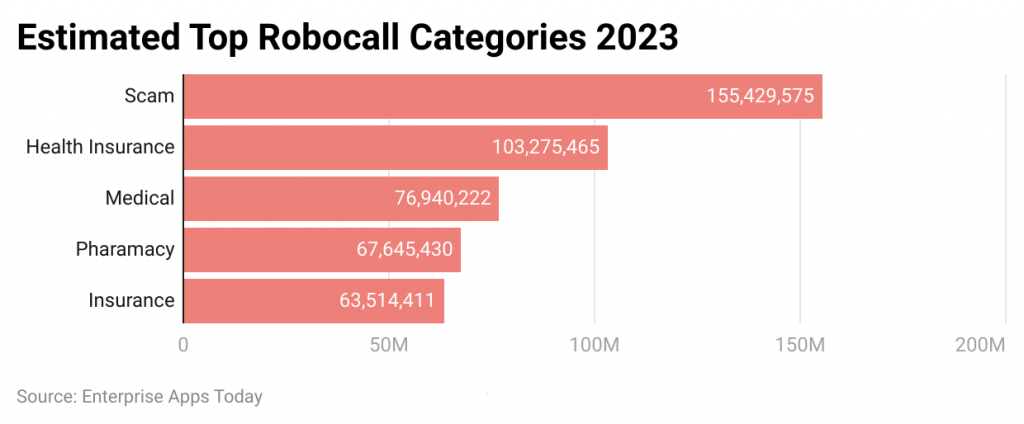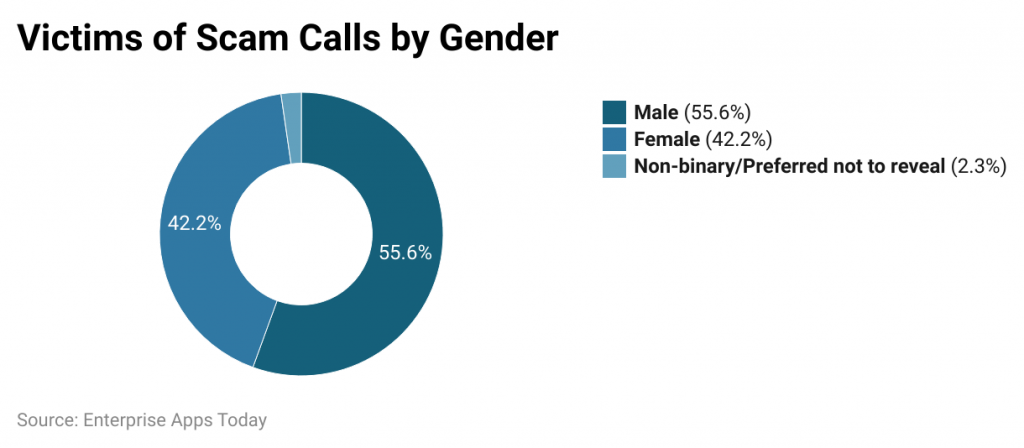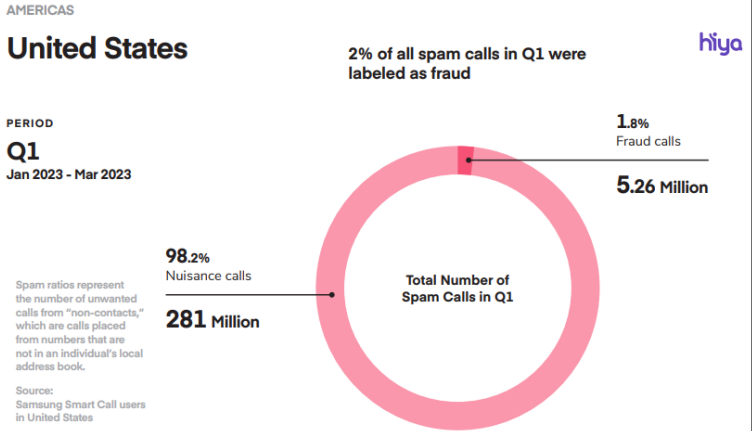20+ Surprising Robocalls Statistics That You Need To Know For 2023

Page Contents
Robocalls Statistics: A robocall refers to a call that transmits pre-recorded messages using auto-dialing software and is delivered to millions of people daily.
They can be used for things like formal announcements and telemarketing campaigns. They can also provide the ideal platform for scams and spam calls.
What are robocalls for? How do you spot a fraudulent robocall? How common are these scams? Where do they originate from? This robocalls statistics will help you to find answers.
To learn the answers to these and other questions check out the list of interesting robocall statistics below.
The Amazing Facts About Robocalls (Editor's Choice)
- By 2023, the market of robocall mitigation is going to value at $5.4 billion and by the end of 2033, it is expected to be $18.05 billion with a 12.7% CAGR.
- According to experts' prediction in 2023, there will be approximately $58 billion subscriber loss because of unwanted robocalls.
- In the United States, some forms of robocalling are legal and by the end of 2023, Robocallsis is expected to reach 82 million.
- On the other hand, due to such an increase in scam calls the U.S. is going to face huge financial losses of $70 billion by the end of 2027.
- Robokiller is the top solution and 99% effective for fighting against unwanted robocalls and spam texts too.
- As of 2023, robocalls increased the rate of fraud-enhanced money loss resulting in $47,908.75 billion across the world.
- As of recent reports, by August 2023 Robokillers have blocked spam calls around 12.7 billion.
- In 2023 as of now, Robokiller has prevented $125.5 billion in losses worldwide
- Whereas the median money lost per scam of robocalls is $1,382.
- The time of average robocall can last for 45 seconds ·
- By 2023, the market of robocall mitigation is going to value at $5.4 billion and by the end of 2033, it is expected to be $18.05 billion with a 12.7% CAGR.
- According to experts' prediction in 2023, there will be approximately $58 billion subscriber loss because of unwanted robocalls.
- In the United States, some forms of robocalling are legal and by the end of 2023, Robocallsis is expected to reach 82 million.
- On the other hand, due to such an increase in scam calls the U.S. is going to face huge financial losses of $70 billion by the end of 2027.
- More than 56% of senior citizens in the United States receive at least seven robocalls per week.
- Every second, around 2,700 robocalls are placed.
- Every phone owner receives an average of 28 robocalls and texts every month.
- According to Market.us’, the chatbot market size is projected to reach USD 4.3 billion by 2032.
- Males are more often victims of fraud than females.
Let's now take a closer look at these and other robocall statistics for 2021.
Robocall Statistics in 2023
- In the U.S. as of August 2023, Americans have received 5.46 billion robocalls and each person receives almost 17 spam calls each day.
- Whereas, per month record of robocalls in 2023 in the United States are followed by January (6.47 billion), February (5.32 billion), March (5.51 billion), April (4.79 billion), May (5.93 billion), June (5.26 billion), July (4.63 billion).
- Across the world, in August robocalls per week (1,233.60 million) weekdays (1,048.56 million), weekends (185.04 million), each day (176.22 million), per minute (1.2 million), and per second (2,040).
- As of 2023, worldwide robocall contribution is highest in the U.S. is 25%, followed by the Russian Federation (19.84%), Germany (7.36%), The Netherlands (4.53%), and France (4%).
- Between the months of January to October 2023, across the world, Truecaller reported more than 17.7 billion.
- As of 2023, fraudulent robocalls have reduced mobile subscribers with a loss of $58 billion in North America, and by the end of 2027, it is going to be a $70 billion loss.
Robocalls Statistics by Categories
 (Source: FitSmallBusiness)
(Source: FitSmallBusiness)
- According to FTC plans for 2023, the topmost robocall category is Scams with 155.4 million.
- The other categories are followed by Health Insurance (103.27 million), Medical (76.9 million), Pharmacy (67.6 million), and Insurance (63.5 million).
Robocalls Statistics by states
- In the United States in 2023, most spam calls were received by the state of Texas resulting in 4,334.8 million with 181 estimated spam calls per person.
- Other top robocall states with estimated spam calls are followed by Arkansas (421.4 million), Oklahoma (504.5 million), South Carolina (635.3 million), and Louisiana (576.9 million).
How many automated calls are made each day?
What did the Covid-19 pandemic do to the robocalling industry?
What amount of money can a victim lose from scam calls?
Check out our list of robocall statistics to learn more.
#1. Scammers now can spoof area codes.
The COVID-19 pandemic impacted everyone, including fraudsters. To make more money, scammers made more calls.
They were also becoming more creative, impersonating employees of well-known businesses and spoofing area numbers and codes.
(Source: WNDU)
#2. Robocalls resumed their pre-pandemic levels in early 2021.
In February 2021, robocall statistics formally returned to their pre-pandemic levels. As the COVID-19 situation grew more serious in April 2020, the number of robocalls fell to 3 billion.
However, both scammers and companies quickly recovered their confidence.
In February 2021, the number of robocalls had gradually increased to pre-pandemic levels with more than 4 billion calls.
(Source: Fortune)
#3. One of the three robocall scam victims picked up the phone because the number was familiar.
Unknown numbers are most common and people won't answer them. This led to scammers adopting a new strategy to get their calls answered.
To gain the recipient's trust, they started spoofing actual companies' phone numbers and acting like them. “Enterprise spoofing” is the term for this.
(Source: FirstOrion)
#4. Fraudulent robocalls accounted for 21% of all calls in 2023.
In 2023, spam robocalls increased by 21% in the United States of America between January and June.
Phone call scams are expected to be above $90 billion loss in America by the end of 2023.
Despite a considerable drop in April, they had already topped January's figures by September.
(Source: Truecaller)
#5. In 2023, around 182 million robocalls were made every day.
In 2023, fraud robocalls have decreased from last year and around 2,115 robocalls per second.
More than 7 billion robocalls were placed in the United States during November, which was the highest monthly total in 2022.
This resulted in 228,030,849 daily calls and more than 1.6 billion weekly calls.
(Source: RoboKiller)
#6. By the end of the 2nd quarter of 2023, the average victim lost $334 to fraud calls.
According to robocalls statistics, by the mid of 2023 around 55% of victims had lost up to $2,000
(Source: Truecaller)
#7. From Jan. to Aug 2023, the number of robocalls has dropped slightly.
According to the FTC plans, robocalls declined by the 1st half of 2023 which dropped by 5 billion but the losses stayed consistent.
T-Mobile claims that US scammers call individuals during working hours and make bogus business calls. By promising fake insurance, warranties, and other things of the like, they are attempting to swindle their victims.
(Source: Threatpost)
#8. In the United States, some forms of robocalling are legal.
Robocalls are not all frauds. Robocalling is acceptable in the United States under the following circumstances:
- Calls from the healthcare provider.
- Calls from debt collection.
- Messages from charities.
- Informational messages, e.g., regarding medical appointments
(Source: Kaspersky)
#9. In 2023, North America will be responsible for 50% of all fraudulent robocall losses.
It is the area with the highest amount of fraudulent robocalls even though just mobile subscribers reside there.
North America is leading the fight against robocalls to address the problem.
(Source: JUNIPER Research)
#10. By the middle of 2021, the average cost of fraudulent robocalls was $1,200.
Scammers have been able to increase their own earnings by leveraging the COVID-19 pandemic and people's anxiety.
As a result, compared to 2019, the price that victims paid for each scam jumped by 20%.
(Source: RoboKiller)
#11. In 2023, losses brought on by fraudulent robocalls are anticipated to rise.
Globally, the amount of money lost due to robocall frauds in 2023 is expected at $53 billion.
By the end of 2025, robocalling is expected to decline for the first time because of the adoption of effective call-blocking frameworks in North America
Analysts anticipate a significant increase in this number. In 2022, fraudulent robocalls are projected to cost $40 billion worldwide.
(Source: JUNIPER Research)
#12. Scammers are more common in certain areas of the United States than others.
Arizona, Florida, and Texas are the top three states where scam calls are reported.
In 2021, the most targeted area codes in the United States were 817,210, and 832 in Dallas-Fort Worth.
(Source: T-Mobile)
#13. In 2023, a spam call lasted an average of 45 seconds.
According to 2023 robocall statistics, spam calls lasted on average 45 seconds. On the other hand, unidentified calls lasted an average of 30 seconds.
Comparatively in the same year, the average length of calls from businesses that were recognized was 2 minutes and 58 seconds.
(Source: Businesswire)
#14. Three of the top five frauds in 2023 are phone fraud.
Phishing and Smishing are the FCC's most popular scams in 2021. This includes fake invoices, text messages, and fraudulent emails from big companies.
Telecommunication fraud is the next most popular scam in 2023. These scams include phone fraud, tech support scams, and bogus government agency frauds.
The top Telecom Frauds are followed by International Revenue Share Fraud (IRSF), Bypass Fraud, Subscription Fraud, Premium Rate Service Fraud, Traffic Pumping Fraud, Refilling Fraud, False Answer Supervision Fraud, Stolen Equipment Fraud, Phishing Equipment Fraud, Phishing, and Wangiri Fraud.
Scammers try to get victims' attention by promising fake lottery wins, offering to raise your credit score, asking for donations, etc.
(Source: Western Bank)
#15. Many consumers frequently complain about scam calls.
T-Mobile robocall statistics show that scam attempts increased more than 200% in 2023.
As of now, the overall volume of scams and spam robocalls is roughly 41%.
Only 43% of worldwide scam victims have downloaded scam blocker apps on their mobile phones.
Scam calls are the most common consumer grievance reported to the FCC (Federal Communications Commission) as of early December 2021.
(Source: T-Mobile)
#16. The average cost of a call blocker is very affordable.
The most used and popular robocall blocker is Hiya which is a free basic service in 2023.
The expensive robocall blocker is YouMail whose VIP plan costs $7.99/month and the regular plan is a free basic service.
Truecaller provides free basic services for accessing fraud robocalls and the premium monthly plan costs $4.49 per month.
Other call blockers are followed by Nomorobo ($1.99/month), RoboKiller ($4.99/month and $39.99/year), and TrapCall ($5.99/month)
(Source: Mashable)
Robocall Demographics
Robocalls fraud victims demographics by 40% men (18-34 years), 46% men (35-44 years), 31% women (18-34 years), and 25% women (35-44 years).
Due to robocalls, the percentage of money loss statistics by race is followed by Hispanic (74%), Caucasian (75%), and African American (43%)
#17. Each year, one in ten adults in the United States is a victim of fraud.
There are several risks to people's security and privacy on the internet. Since identity theft is so simple, the majority of scams today take place online.
Despite this, conventional approaches are still widely used. One of the most prevalent types of fraud in the United States is phone fraud.
(Source: Legal jobs)
#18. Males are more often victims of fraud than females.
 (Source: fitsmallbusiness.com)
(Source: fitsmallbusiness.com)
Compared to older men and younger women, younger men are more prone to fall victim to phone scams.
Comparatively, only 25% of women between the ages of 35 and 44 and 31% of women between the ages of 18 and 34 were scammed.
Phone scam statistics by gender are followed by male (55.6%), female (42.2%), and non-binary (2.3%).
(Source: Truecaller)
#19. In 2020, fraudsters mainly targeted people aged 60 to 70.
A total number of 179,757 fraud cases were reported by US adults aged 60 to 70. People aged 35 to 45 were the second-most targeted demographic.
With 35,884 cases documented, young adults under 19 were the least frequently targeted.
(Source: Statista)
#20. In 1st half of 2023, the citizens in the United States received 31 billion robocalls Whereas, robocall scams estimated losses resulted in $33 billion
This year the state of the robocall has decreased by 21% from last year.
On the other hand scam losses of robocalls were prevented by almost $91 million by Robokiller.
(Source: Truecaller)
#21. The nation receiving the highest number of robocalls in 2019 was Spain.

According to the call-blocking service Hiya, the United States received the most robocalls overall in 2023.
In the 1st quarter of 2023, 0nly 1.8% of spam calls were determined as fraud which was experienced by 5.26 million American people, and 98.2% of nuisance calls are experienced by 281 million people of America.
Other countries, such as the US, Brazil, Mexico, Argentina, Chile, the UK, France, Italy, and Australia are also frequently affected by robocall scams.
(Source: ZDNet)
#22. In 2023, half of the young adults in the United States said they had lost money to scammers.
Senior citizens are frequently the victims of robocall scams. In 2023, just 18% of people in the 75–70 age group reported losing money to a scam.
In contrast, 50% of young individuals between the ages of 20 to 29 were scammed.
Younger people contribute less money than older people despite being more inclined to fall into the trap.
While people in their 20s lost approximately $300 per person, people aged 70 and older lost an average of $650.
(Source: Newsy)
#23. As of July 2021, victims of scam calls suffered an average loss of $502
This amount has fluctuated considerably over the last few years. It decreased to $275 in 2015 from $489 in 2014.
In 2017, it increased once more to $430 before falling once again to $244 in 2019.
(Source: Truecaller)
Conclusion
Robocall statistics indicate that fraudulent calls are an increasing issue. Although some businesses utilize them for legal reasons, the rise in misuse is concerning. In addition, as technology advances, robocalls will likely become even more common and sophisticated. This means that it is more important than ever for consumers to be aware of the dangers of this type of spam and take steps to protect themselves.
Furthermore, installing a spam call-blocking application or using the security features offered by their network operator are two ways that users can protect themselves.
However, governments should join the fight against shady robocalls to solve the issue.
Sources

Barry is a lover of everything technology. Figuring out how the software works and creating content to shed more light on the value it offers users is his favorite pastime. When not evaluating apps or programs, he's busy trying out new healthy recipes, doing yoga, meditating, or taking nature walks with his little one.